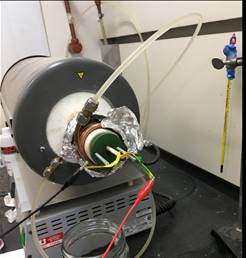La spettroscopia di impedenza elettrochimica
Panoramica
Fonte: Kara Ingraham, Jared McCutchen e Taylor D. Sparks,Dipartimento di Scienza e Ingegneria dei Materiali, Università dello Utah, Salt Lake City, UT
La resistenza elettrica è la capacità di un elemento del circuito elettrico di resistere al flusso di elettricità. La resistenza è definita dalla legge di Ohm:
 (Equazione 1)
(Equazione 1)
Dove  è la tensione ed è la
è la tensione ed è la  corrente. La legge di Ohm è utile per determinare la resistenza dei resistori ideali. Tuttavia, molti elementi del circuito sono più complessi e non possono essere descritti solo dalla resistenza. Ad esempio, se viene utilizzata una corrente alternata (CA), la resistività dipenderà spesso dalla frequenza del segnale CA. Invece di utilizzare solo la resistenza, l'impedenza elettrica è una misura più accurata e generalizzabile della capacità di un elemento circuitale di resistere al flusso di elettricità.
corrente. La legge di Ohm è utile per determinare la resistenza dei resistori ideali. Tuttavia, molti elementi del circuito sono più complessi e non possono essere descritti solo dalla resistenza. Ad esempio, se viene utilizzata una corrente alternata (CA), la resistività dipenderà spesso dalla frequenza del segnale CA. Invece di utilizzare solo la resistenza, l'impedenza elettrica è una misura più accurata e generalizzabile della capacità di un elemento circuitale di resistere al flusso di elettricità.
Più comunemente, l'obiettivo delle misurazioni dell'impedenza elettrica è la deconvoluzione dell'impedenza elettrica totale di un campione in contributi provenienti da diversi meccanismi come resistenza, capacità o induzione.
Procedura
- Ottenere un modulo di prova e collegarlo agli strumenti EIS tramite due elettrodi. Il modulo di test, illustrato nella Figura 3,fornisce dati che possono essere utilizzati per modellare un circuito semplice e noto. Può essere utilizzato per confermare che i fili sono collegati correttamente alla macchina e che tutte le parti della macchina funzionano.

Figura 3: Modulo d
Risultati
I risultati dell'EIS sono spesso presentati in un grafico di Nyquist, che mostra l'impedenza reale rispetto all'impedenza complessa ad ogni frequenza testata. Il grafico dell'esperimento eseguito può essere visto nella Figura 6.

Figura 6: Screenshot del computer dopo che è stat..
Applicazione e Riepilogo
La spettroscopia di impedenza elettrochimica è uno strumento utile per determinare in che modo un nuovo materiale o dispositivo impedisce il flusso di elettricità. Lo fa applicando un segnale CA attraverso gli elettrodi collegati al campione. I dati vengono raccolti e tracciati dal computer nella pianura complessa. Con l'aiuto del software, il grafico può essere modellato su parti specifiche di un circuito. Questi dati possono spesso essere molto complicati e richiedono un'attenta analisi. Questa tecnica, per quanto c...
Tags
Vai a...
Video da questa raccolta:

Now Playing
La spettroscopia di impedenza elettrochimica
Materials Engineering
23.1K Visualizzazioni

Materialografia ottica parte1: preparazione del campione
Materials Engineering
15.3K Visualizzazioni

Materialografia ottica parte 2: analisi dell'immagine
Materials Engineering
11.0K Visualizzazioni

Spettroscopia fotoelettronica a raggi X
Materials Engineering
21.5K Visualizzazioni

Diffrazione dei raggi X
Materials Engineering
88.6K Visualizzazioni

Fasci ionici focalizzati
Materials Engineering
8.8K Visualizzazioni

Solidificazione direzionale e stabilizzazione di fase
Materials Engineering
6.5K Visualizzazioni

Calorimetria differenziale a scansione
Materials Engineering
37.3K Visualizzazioni

Diffusività termica e metodo del flash laser
Materials Engineering
13.2K Visualizzazioni

Galvanizzazione di pellicole sottili
Materials Engineering
20.0K Visualizzazioni

Analisi dell'espansione termica tramite dilatometria
Materials Engineering
15.7K Visualizzazioni

Materiali compositi a matrice ceramica e le loro proprietà di flessione
Materials Engineering
8.1K Visualizzazioni

Leghe nanocristalline e stabilità dimensionale dei nano-grani
Materials Engineering
5.1K Visualizzazioni

Sintesi di idrogel
Materials Engineering
23.6K Visualizzazioni

